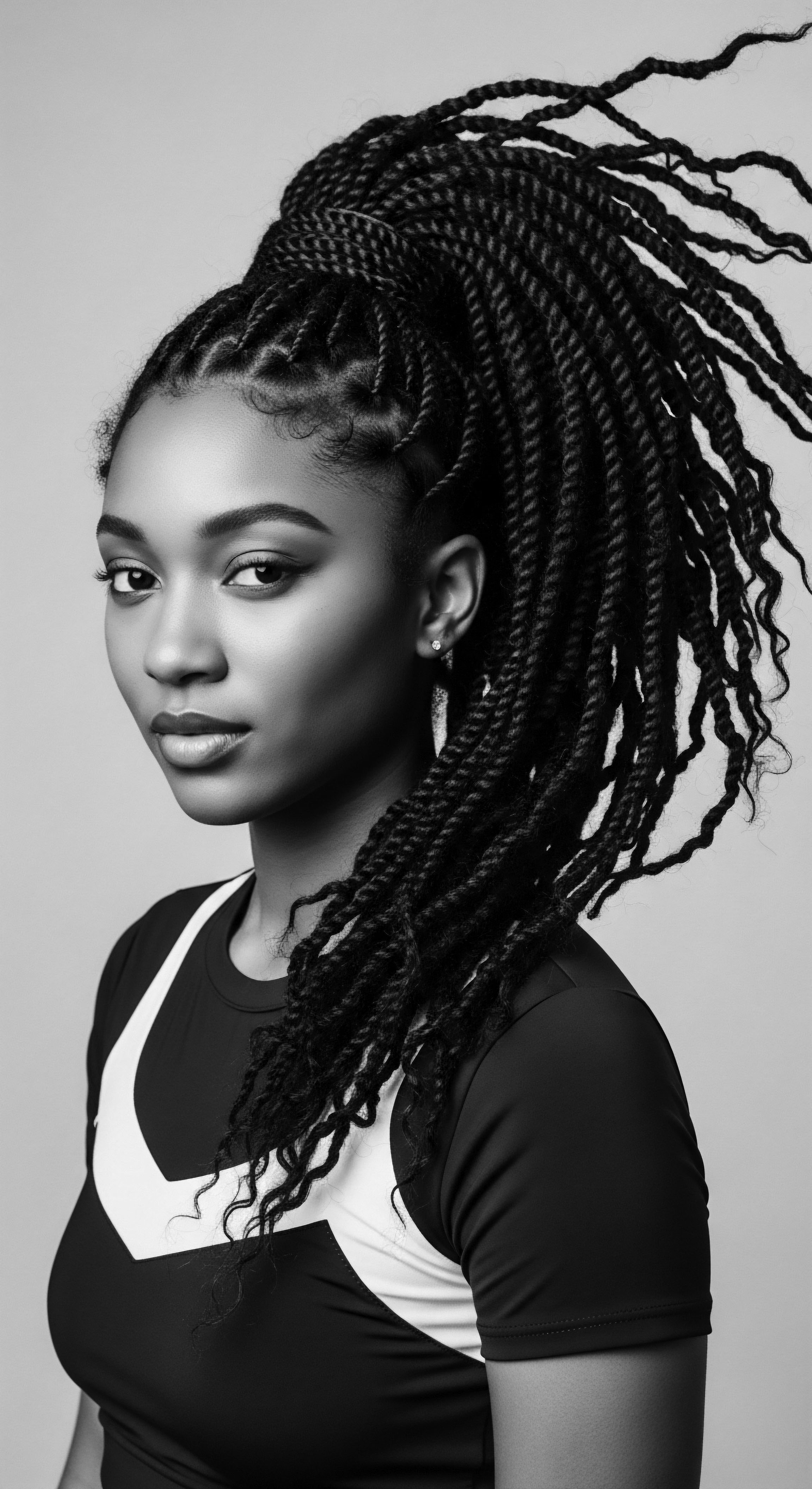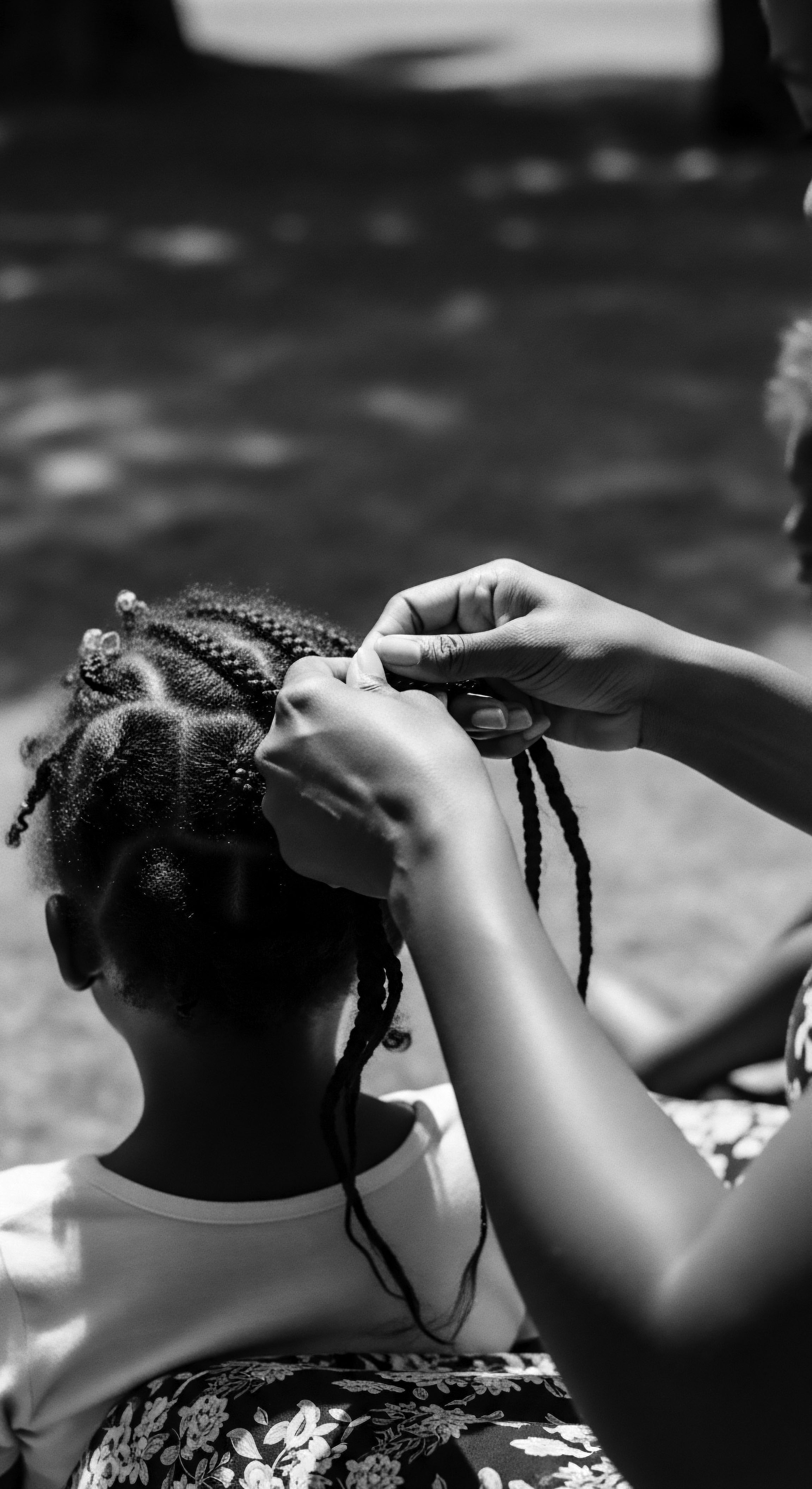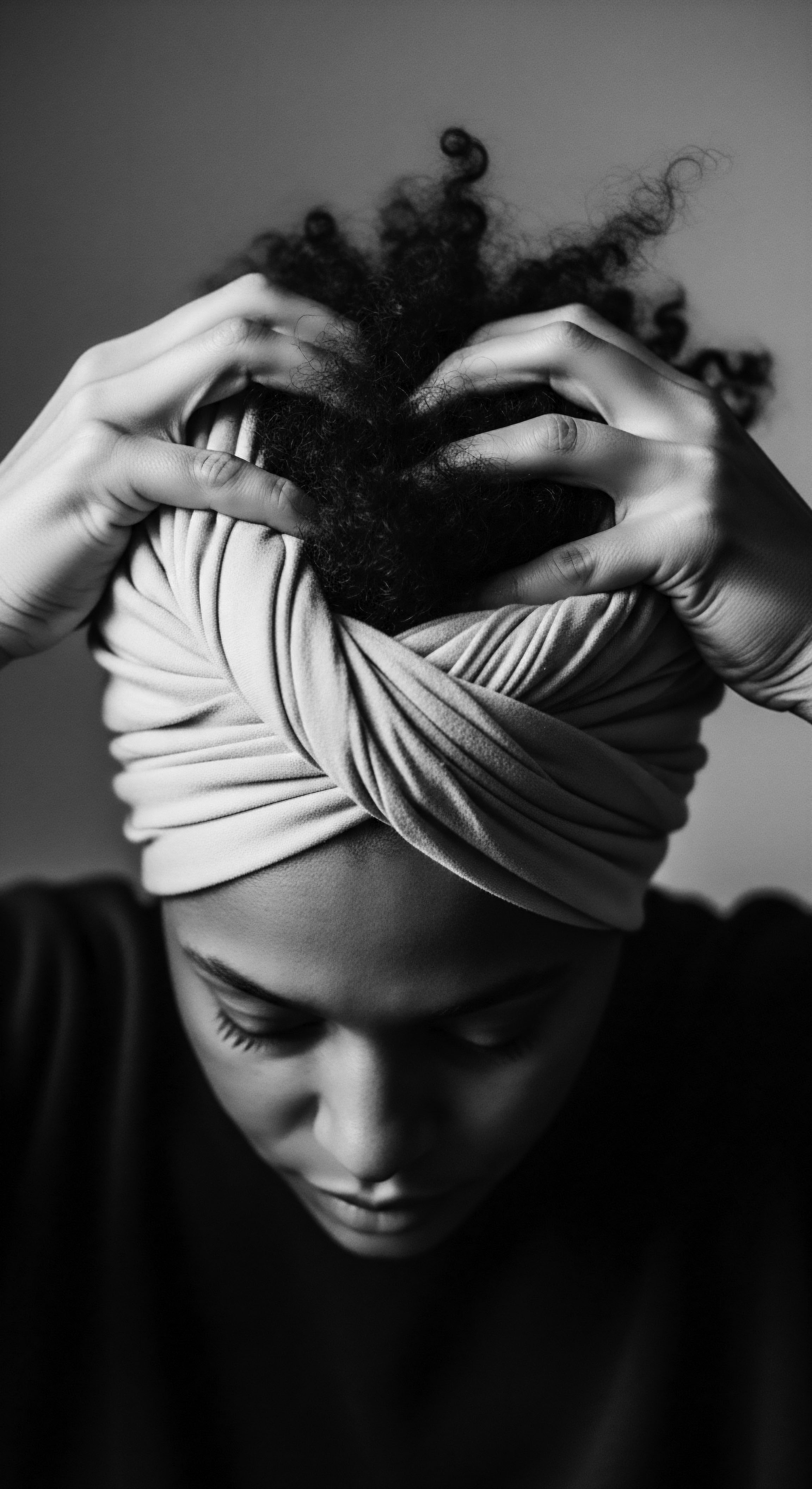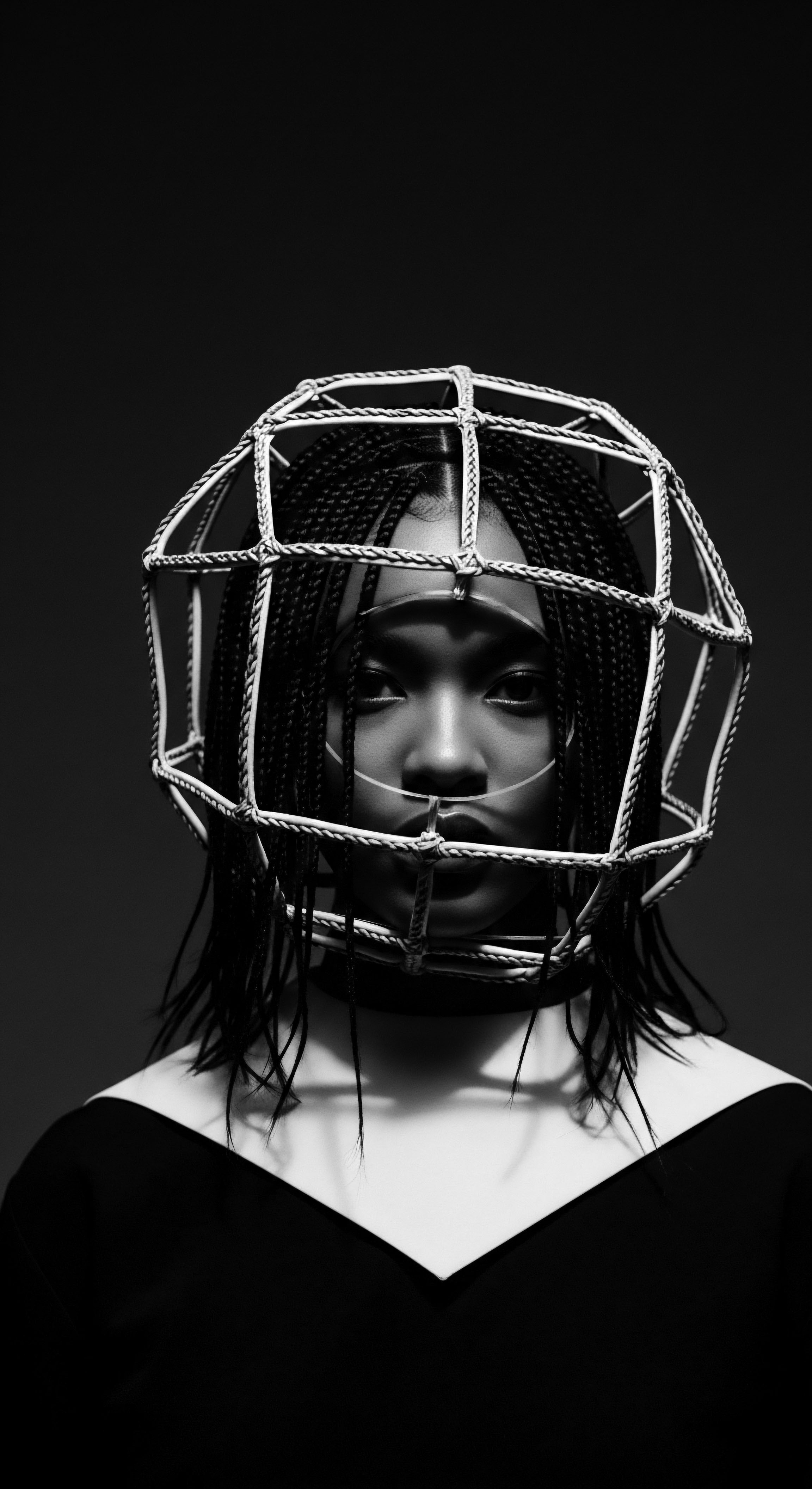
Fundamentals
The very essence of hair, a precious filament woven from protein, stands as a testament to biological marvel. Yet, this delicate construct, particularly for those whose strands coil and curve in intricate patterns, faces daily challenges to its integrity. Among these, the phenomenon known as friction damage represents a silent, persistent adversary.
At its most elemental, friction damage can be understood as the wear and tear inflicted upon the hair fiber when it rubs against itself, against other hair, or against external surfaces like fabrics, combs, or pillows. This continuous mechanical stress, often subtle yet relentless, gradually compromises the hair’s outer protective layer.
Imagine the hair’s cuticle, a shield of overlapping scales akin to shingles on a roof, lying smoothly along the strand. This pristine arrangement grants hair its luster and strength, sealing in vital moisture. When friction occurs, these scales are subjected to abrasion. The rubbing motion can lift, chip, and even entirely remove these delicate cuticular layers.
This exposure then leaves the hair’s inner cortex, the core of its strength and elasticity, vulnerable to environmental aggressors and further mechanical stress. The repeated action of dislodging these protective plates diminishes the hair’s natural defenses, leading to a cascade of unwelcome changes.
Friction damage is the gradual compromise of hair’s outer protective layer, the cuticle, caused by abrasive contact, leading to compromised structural integrity.
For textured hair—the coils, kinks, and waves that speak to ancient lineages—this susceptibility is often amplified by its inherent architecture. The very twists and turns of these magnificent strands create natural points of contact and overlap, increasing hair-on-hair friction. Unlike straight hair, which may slide past itself with relative ease, coily and kinky textures inherently intertwine, creating more opportunities for abrasive interaction.
Furthermore, the natural elasticity and often reduced number of cuticle layers in some textured hair types can render them more prone to the initial impact of friction. This predisposition means that even routine acts of care, if approached without mindful intention, can inadvertently contribute to this form of structural compromise.
Consider the daily rituals ❉ the swift passage of fingers through a cloud of coils, the gentle embrace of a cotton pillowcase during slumber, or the rhythmic swing of a styled braid against clothing. Each instance, seemingly innocuous on its own, adds to a cumulative burden. Over time, the effects of friction damage manifest visibly ❉ hair may appear dull, lacking its inherent sheen, as the roughened cuticles no longer reflect light uniformly.
It can become brittle, prone to snagging and tangling, and ultimately, vulnerable to breakage. This silent erosion of the hair’s fortitude speaks volumes about the delicate balance between external interaction and intrinsic resilience.

Intermediate
Moving beyond the basic conceptualization, the meaning of friction damage unfolds into a more intricate interplay of biophysical realities and historical echoes for textured hair. This form of physical insult to the hair shaft is not a singular event but a continuous process, a slow unveiling of the hair’s inner vulnerabilities. Understanding its complexities requires an appreciation for the specific architecture of textured hair and the methods by which its ancestors sought to protect it, even without the modern lexicon of trichology.
The very helical structure of textured hair presents a unique challenge when it comes to friction. Each curl, each coil, acts as a point of potential entanglement and abrasion. When strands interlock, the constant movement inherent in daily life—walking, sleeping, even the gentle sway of the head—causes these interlocked fibers to rub against one another. This internal friction, often overlooked, is a significant contributor to cuticle disruption.
External sources, while more obvious, compound this issue. Textiles like cotton, with their uneven, absorbent fibers, can act as microscopic sandpaper against the hair, particularly when hair is dry. Combs and brushes with rough seams or inappropriate bristle density can also shear away the protective cuticular layers.
The mechanical action of friction against the hair causes a phenomenon known as cuticle lifting. Under microscopic examination, one can observe the normally tightly bound cuticle scales begin to fray and detach from the hair shaft. This process exposes the underlying cortex, which is composed of keratin proteins.
Once exposed, the cortex is susceptible to further damage from the environment, including moisture loss, protein degradation, and oxidative stress. The consequence is a loss of elasticity, increased porosity, and a diminished capacity to retain hydration, rendering the hair more susceptible to breakage, tangles, and dullness.
Friction damage on textured hair is exacerbated by its coiled structure, leading to cuticle lifting and cortex exposure, which then compromises hair’s moisture retention and elasticity.
Ancestral practices, born of necessity and deep observational wisdom, often intuitively understood the need to mitigate this constant wear. Throughout history, communities with textured hair developed sophisticated methods that, while perhaps not framed in scientific terms, served as highly effective protective measures against friction. These practices ranged from specific styling techniques to the deliberate choice of materials for wraps and adornments.
For instance, the use of hair oils and butters, derived from indigenous plants, created a lubricious barrier, reducing the abrasive forces between strands and external elements. The communal practice of braiding and twisting, often performed with meticulous care, served to consolidate individual strands into larger, more cohesive units, thereby minimizing the surface area exposed to friction and tangling.
The rich heritage of textured hair care, passed down through generations, often prioritized methods that gently guarded the hair’s integrity. These included:
- Oiling and Sealing ❉ The systematic application of plant-based oils and butters, like shea butter or coconut oil, served as a natural lubricant, allowing strands to glide past each other and against fabrics with reduced resistance. This practice, often a shared family ritual, fundamentally lowered the coefficient of friction.
- Protective Styling ❉ Braiding, twisting, and coiling the hair close to the scalp or into contained forms minimized exposure to environmental friction, preventing tangles and preserving length. These styles, often imbued with cultural and spiritual significance, were a living testament to an understanding of hair preservation.
- Night Protection ❉ While not always explicitly cited as “friction damage prevention,” the historical use of head wraps, bonnets, or specialized caps fashioned from smooth materials, akin to silk or satin, instinctively protected hair during sleep. This reduced the harsh abrasion of rough sleeping surfaces.
- Mindful Detangling ❉ Oral traditions and observed practices emphasized gentle, patient detangling, often with wide-toothed implements or fingers, working from ends to roots, to avoid tearing and unnecessary stress on already fragile, friction-prone areas.
These practices, cultivated over centuries, speak to a profound, inherited understanding of hair’s needs. They are not merely quaint customs but represent sophisticated solutions to the inherent challenges of textured hair, long before the advent of modern trichology. The continuation of these traditions today is not simply an aesthetic choice; it represents a reaffirmation of ancestral wisdom in safeguarding the hair’s health against the insidious effects of friction.

Academic
The academic delineation of friction damage transcends its basic and intermediate conceptualizations, asserting its significant meaning as a critical mechanism of degradation in textured hair, deeply interwoven with cultural histories, societal pressures, and the very expression of identity across the African diaspora. At its most precise, friction damage refers to the irreversible structural alteration of the hair shaft’s cuticle layers and, consequently, its underlying cortex, resulting from repeated, non-catastrophic mechanical abrasive forces. This definition encompasses not only the direct physical outcome but also its profound implications for the hair’s hydrophobic properties, tensile strength, elasticity, and overall aesthetic integrity. The complex interplay of hair’s morphological characteristics, particularly the elliptical cross-section and higher curl index of textured hair, amplifies its susceptibility to this form of damage, as these structural nuances increase the surface area contact and inter-fiber entanglement, thereby raising the coefficient of friction during manipulation and daily wear.
From an academic perspective, understanding friction damage necessitates a multi-disciplinary approach, drawing from material science, trichology, anthropology, and cultural studies. The unique architecture of textured hair, characterized by its varying curl patterns—from loose waves to tightly wound coils—leads to numerous points of contact between individual hair fibers. This auto-abrasion, or hair-on-hair friction, creates microscopic tears and lifting of the cuticle scales. When combined with external friction from tools (combs, brushes), textiles (pillowcases, scarves), or environmental factors (wind, dust), the cumulative effect becomes exponentially detrimental.
The scales, once lifted, snag on neighboring strands, increasing tangles and further exacerbating damage during detangling. This progressive erosion of the cuticle compromises the hair’s natural barrier function, leading to accelerated moisture loss and increased permeability to environmental aggressors, often initiating a cycle of dryness, brittleness, and breakage that can be difficult to interrupt without informed intervention.
One might consider the pervasive historical experience of Black women in the United States during periods of profound social and economic transformation, particularly after Emancipation. As documented in scholarly works like Ayana D. Byrd and Lori L. Tharps’s (2014) comprehensive study, Hair Story ❉ Untangling the Roots of Black Hair in America, the societal pressures to conform to Eurocentric beauty standards led to a significant shift in hair care practices within Black communities.
Prior to this, many ancestral hair practices emphasized protective styling—such as cornrowing, twisting, and intricate braiding—which inherently minimized exposure to external friction and consolidated hair strands, preserving their delicate integrity. This period, however, saw a marked increase in the use of chemical relaxers and hot combs to achieve straight hair textures. The very process of chemical straightening fundamentally alters the disulfide bonds within the hair, weakening its structural resilience. Subsequently, the daily maintenance of straightened hair—requiring frequent brushing, combing, and heat styling—introduced unprecedented levels of mechanical stress and friction.
Academic analysis reveals friction damage as a complex degradation of textured hair, significantly impacted by cultural shifts and historical styling practices across the diaspora.
This historical shift provides a compelling case study for the compounded effects of friction damage. While ancestral practices intuitively safeguarded hair by minimizing manipulation and external contact, the pursuit of assimilation often meant abandoning these protective rituals in favor of styles that demanded constant, high-friction intervention. The result was widespread hair breakage, thinning, and a chronic cycle of damage that was not merely cosmetic but also had profound psychological implications, tying hair health to issues of self-esteem and cultural acceptance.
The very meaning of hair, once a symbol of spiritual connection and cultural identity, became fraught with the burdens of conforming to external ideals, inadvertently increasing its vulnerability to friction. The historical record indicates a significant increase in reported hair loss and scalp conditions during this era, directly correlating to the new, high-friction styling practices, a stark contrast to the often healthier, more resilient hair observed in communities maintaining traditional care methods.
Furthermore, the academic lens allows for an analysis of the psychosocial ramifications of persistent friction damage. When hair is constantly breaking and failing to retain length, it can diminish an individual’s sense of hair wellness and intrinsic beauty. This is particularly salient within communities where hair has historically been a powerful cultural marker and a canvas for identity expression. The inability to achieve desired hair health due to pervasive, yet often invisible, friction damage can contribute to feelings of frustration, a lack of self-efficacy in hair care, and even disengagement from one’s natural hair texture.
Consider the nuanced understanding of inter-fiber friction in different hair types. Research indicates that the higher curvature of highly coiled hair types results in a greater number of inter-fiber contact points per unit length compared to straight hair. This leads to a higher propensity for internal friction damage, even with minimal external manipulation. For instance, a study published in the Journal of Cosmetic Science (Khumalo et al.
2007) examining the properties of scalp hair in different racial groups noted that African hair exhibits a lower tensile strength and a greater propensity for breakage at the point of curvature, particularly when subjected to repeated mechanical stress. This inherent structural vulnerability means that practices designed to minimize friction are not merely optional but are fundamental to preserving the structural integrity and health of textured hair. This observation underscores the inherited wisdom embedded in ancestral care practices that, for millennia, centered on reducing manipulation and providing lubrication, thereby indirectly mitigating the scientific realities of friction damage.
The following table delineates the ancestral responses to friction damage and their contemporary scientific corroborations, highlighting the continuity of wisdom:
| Ancestral Practice Oiling and Buttering Hair |
| Primary Mechanism of Protection Created a smooth, lubricious barrier, reducing surface roughness. |
| Scientific Principle Mitigated by Practice Lowers the coefficient of friction between hair strands and external elements, preventing cuticle lifting and abrasion. |
| Ancestral Practice Protective Styling (Braids, Twists) |
| Primary Mechanism of Protection Consolidated individual strands into larger, contained units; minimized exposure. |
| Scientific Principle Mitigated by Practice Reduces inter-fiber friction and limits external mechanical abrasion by presenting a smaller, cohesive surface area to environmental stressors. |
| Ancestral Practice Night Wraps & Head Coverings |
| Primary Mechanism of Protection Protected hair from abrasive contact with sleeping surfaces and elements. |
| Scientific Principle Mitigated by Practice Prevents mechanical wear from friction with bedding materials, safeguarding the cuticle from nightly damage and preserving moisture. |
| Ancestral Practice Finger Detangling & Gentle Combing |
| Primary Mechanism of Protection Slow, methodical separation of tangles, often with natural implements. |
| Scientific Principle Mitigated by Practice Minimizes tensile stress and breakage at points of entanglement, preserving the hair's elasticity and preventing catastrophic breakage. |
| Ancestral Practice These timeless methods, originating from ancestral knowledge, continue to resonate with modern trichological understanding of hair preservation. |
In conclusion, the academic meaning of friction damage in textured hair is not simply a biological deficiency but a dynamic concept, deeply shaped by historical contexts, cultural imperatives, and inherited wisdom. Its understanding allows for a comprehensive appreciation of the challenges faced by textured hair and the ingenuity of ancestral practices that sought to preserve its integrity, often against overwhelming odds. This integrated perspective invites a deeper reverence for the hair itself—not just as a biological structure but as a living testament to resilience and adaptation, a profound link to ancestral heritage.

Reflection on the Heritage of Friction Damage
The journey through the complexities of friction damage, particularly as it pertains to textured hair, inevitably leads us back to the wellspring of heritage. For generations, the care of textured hair has served as more than a routine; it has been a profound act of identity, resistance, and continuity. From the meticulous braiding rituals of ancient African communities to the resilient innovations developed in the diaspora, practices surrounding hair have always carried the weight of wisdom, passed hand to loving hand.
The struggles against external forces—be they the arid climate, the labor of the fields, or the insidious pressures of imposed beauty standards—forged a collective body of knowledge. This knowledge, though often unwritten, held the keys to mitigating mechanical stressors, including the subtle erosion caused by friction.
The echoes from ancestral practices whisper a gentle reminder ❉ true hair wellness is not merely about addressing damage, but about honoring the hair’s inherent nature and safeguarding its future. The understanding of friction damage, therefore, becomes a pathway to reconnecting with those traditions. It is a validation of the ingenious ways our forebears preserved the integrity of strands through careful lubrication, strategic containment, and gentle touch. Each coiled strand carries the memory of these ancient rhythms of care, a testament to resilience forged in the face of countless challenges.
As we reflect on the evolving meaning of friction damage, we acknowledge that the challenges persist, albeit in new forms. Yet, the foundational truths remain ❉ protection, gentleness, and nourishment are timeless principles. The conscious choice to adopt practices that minimize friction today—be it through satin-lined bonnets, mindful detangling, or the generous application of nourishing oils—is not merely a modern hair care strategy.
It is an act of honoring heritage, a living continuation of the tender thread that binds us to those who came before. In safeguarding our hair from this quiet wear, we are not just preserving its physical health; we are affirming a legacy of resilience, beauty, and profound self-acceptance, allowing each strand to unfurl as an unbound helix, vibrant and free.

References
- Byrd, Ayana D. and Lori L. Tharps. Hair Story ❉ Untangling the Roots of Black Hair in America. St. Martin’s Press, 2014.
- Khumalo, Ncoza D. et al. “What is normal hair? A histological and electron microscopic study of scalp hair in different racial groups.” Journal of Cosmetic Science, vol. 58, no. 1, 2007, pp. 65-72.
- Khayesi, Mukhwana. Hair in African Perspectives. Langaa RPCIG, 2009.
- Robbins, Clarence R. Chemical and Physical Behavior of Human Hair. 5th ed. Springer, 2012.
- Goldsmith, Lowell A. Physiology, Biochemistry, and Molecular Biology of the Skin. Oxford University Press, 2012.
- Gittens, Joan. African American Hair Story ❉ A Journey from Ancient Creations to Thriving Modern Styles. Xlibris Corporation, 2017.
